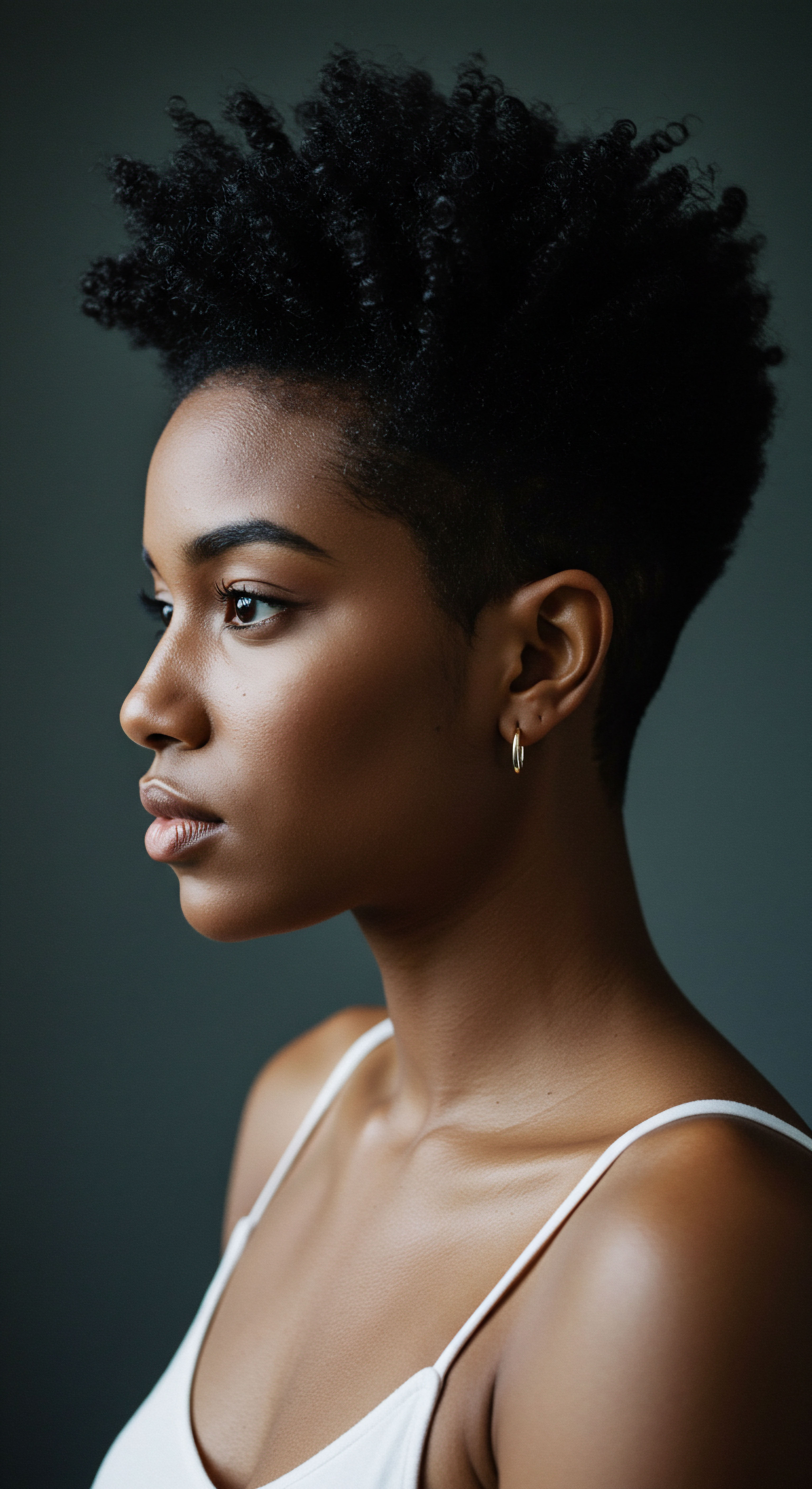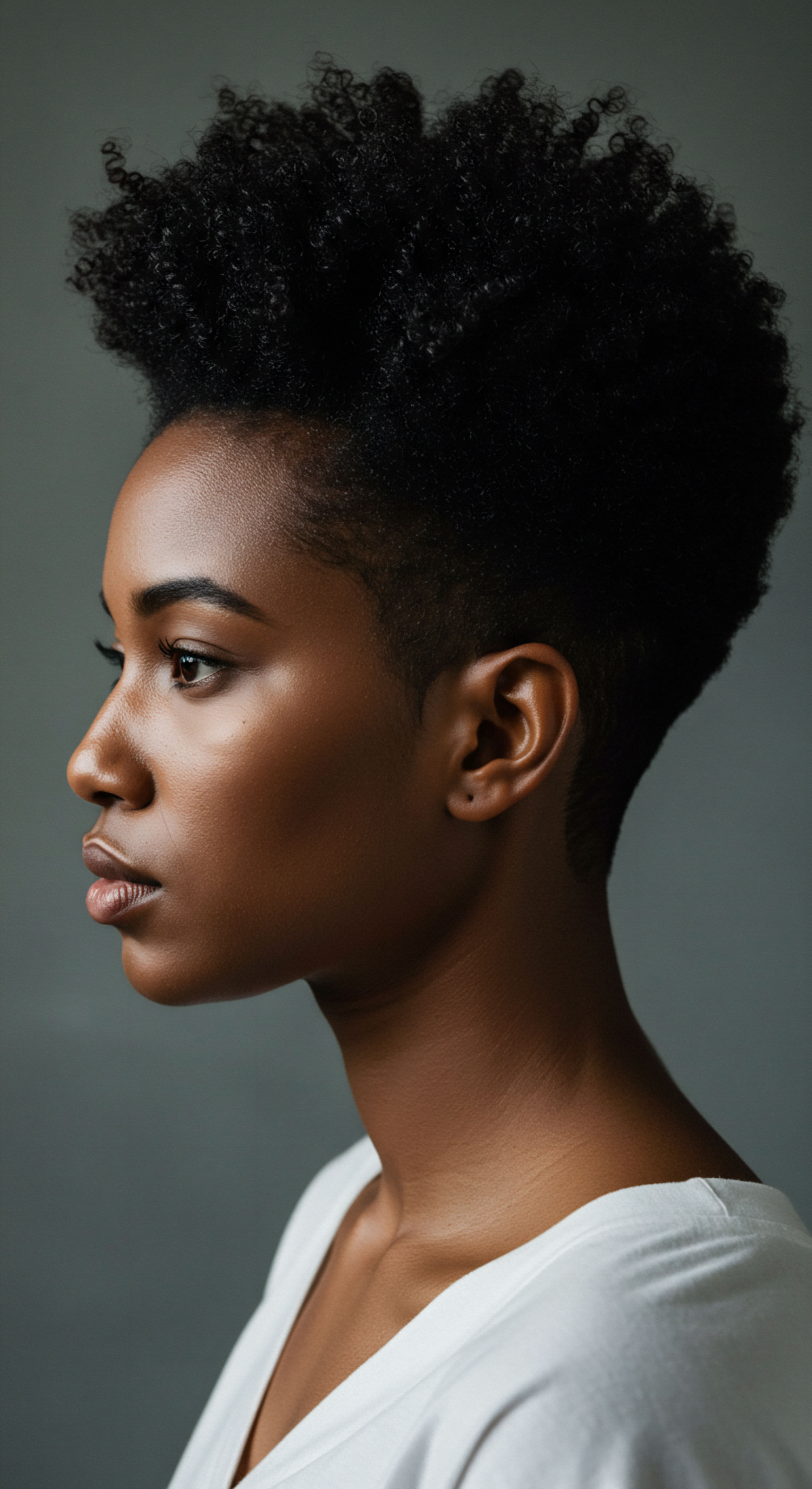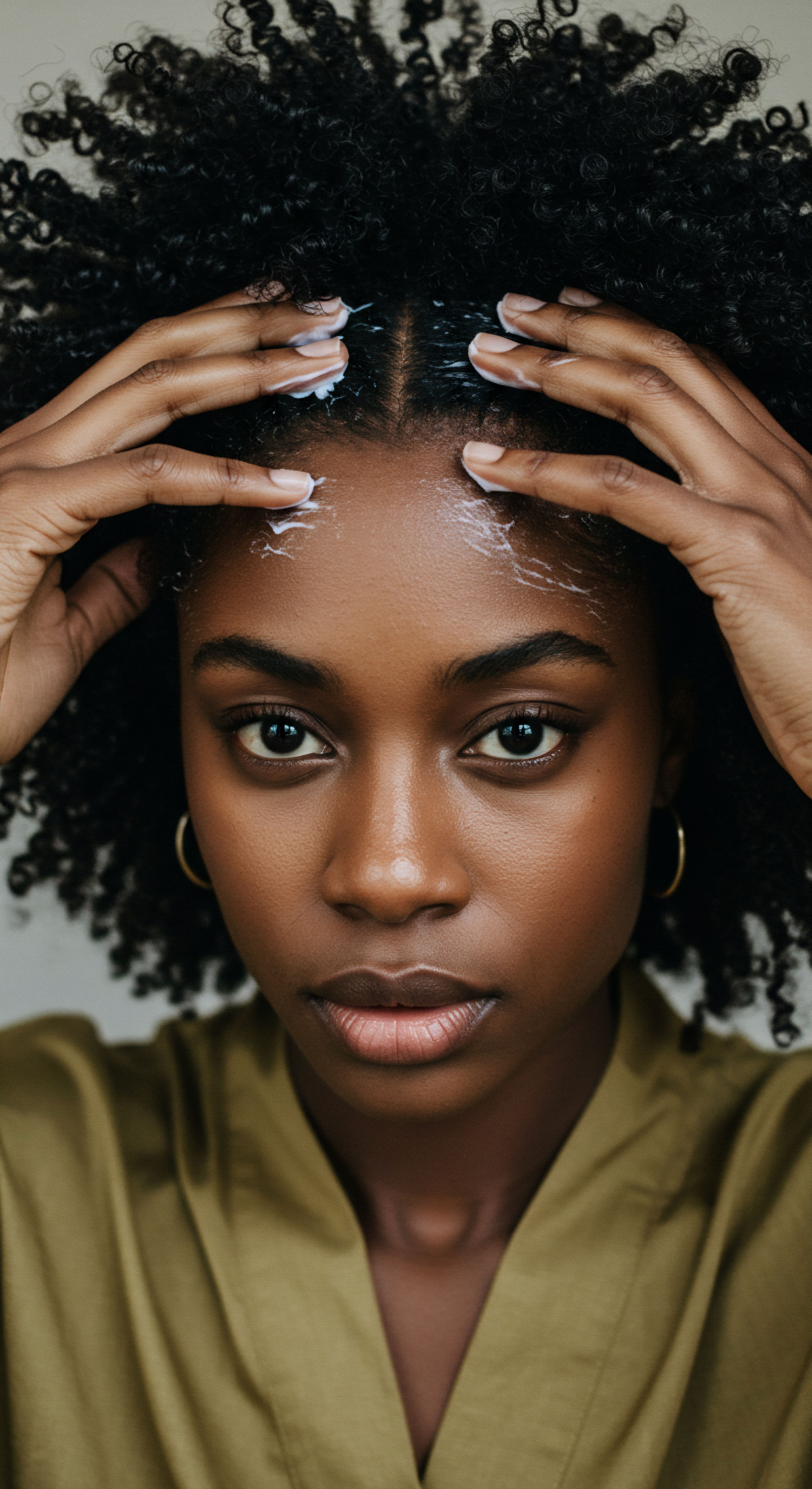
Roots
The strands that crown our heads carry more than just color and curl; they hold whispers of ages past, echoes of hands that tended, herbs that soothed, and wisdom passed down through generations. To truly understand how ancient hair care practices shaped the vitality of hair over centuries, we must first allow ourselves to feel the deep resonance of those early rituals. It is a quiet invitation to recognize hair not merely as a biological outgrowth, but as a living archive, a repository of cultural knowledge and ancestral care. Every twist, every coil, every wave bears witness to practices that were not fleeting trends, but profound commitments to health and beauty, intrinsically linked to the very essence of communal life.
Across diverse civilizations, the relationship with hair was rarely casual. It was often imbued with spiritual significance, social standing, and practical purpose. From the meticulously braided styles of ancient Egypt to the rich, oil-treated locks of early Indian cultures, hair care was a deliberate act, a sustained conversation between individual and environment. These practices were not born of arbitrary whim, but from an intimate observation of nature and a deep understanding of natural resources.

The Hair’s Earliest Foundations
Consider the foundational elements of hair itself. Our modern understanding of hair anatomy, with its cortex, cuticle, and medulla, helps us appreciate the intricate structures ancient peoples instinctively nurtured. They might not have used microscopes, yet their methods often aligned remarkably with what we now understand about maintaining the integrity of these delicate components.
For instance, the emphasis on protective styling in many ancient African cultures, where hair was often braided, twisted, or coiled close to the scalp, served to shield the hair shaft from environmental aggressors. This physical protection reduced breakage and retained moisture, allowing strands to grow longer and stronger over time.
Ancient hair practices often served as intuitive protective measures, aligning with modern scientific understanding of hair structure and health.
The earliest forms of hair care were, at their heart, about preservation. The desert climates of ancient Egypt, for example, necessitated rigorous moisture retention. Their reliance on rich oils like castor, moringa, and almond was not simply for shine; these emollients formed a barrier against the drying sun and wind, minimizing moisture loss from the hair shaft. Such continuous lubrication would have contributed significantly to the hair’s elasticity and resilience, preventing the brittleness that leads to fracture.

What Ancient Practices Revealed About Hair Longevity?
The long-term impact of these early methods on hair health across generations becomes clearer when we examine the sustained use of specific ingredients and techniques. Ancient societies often utilized readily available botanicals, clays, and animal fats. The consistent application of these natural elements, devoid of harsh synthetic chemicals, allowed hair and scalp to maintain a more balanced, less irritated state. Over generations, this would have contributed to a healthier scalp microbiome, fostering a conducive environment for robust hair growth.
The absence of modern chemical treatments, such as harsh dyes, relaxers, or perms, meant that ancient hair was not subjected to the structural alterations and damage that became commonplace in later eras. While some cultures used natural dyes like henna or indigo, these generally worked by coating the hair shaft rather than penetrating and altering its internal bonds, thus posing less risk to structural integrity. The hair’s natural composition, particularly its keratin protein, remained largely undisturbed, allowing for its inherent strength to persist.

Understanding Scalp Vitality in Antiquity
A truly vital aspect of ancient hair care, often overlooked in modern discussions, was the profound attention paid to the scalp. Many historical practices involved regular scalp massages, often with infused oils or herbal concoctions. These massages were not just relaxing; they stimulated blood circulation to the hair follicles, ensuring a steady supply of nutrients and oxygen. A well-nourished follicle is a productive follicle, capable of generating stronger, healthier strands.
- Herbal Rinses ❉ Many cultures utilized rinses made from plants like rosemary, nettle, or chamomile, which possess astringent or soothing properties that could help maintain scalp hygiene and reduce inflammation.
- Clay Treatments ❉ Certain clays, such as rhassoul clay from Morocco, were used for centuries as natural cleansers and purifiers, absorbing excess oil and impurities from the scalp without stripping its natural moisture barrier.
- Oil Applications ❉ Consistent application of natural oils like olive, sesame, or coconut oil to the scalp provided deep conditioning, preventing dryness and flakiness, and creating a healthy environment for hair growth.
The cumulative effect of such diligent scalp care over generations would have been significant. A healthy scalp is the very bedrock of healthy hair. Without the constant assault of harsh detergents or styling chemicals, and with regular nourishment and gentle cleansing, the scalp’s natural defenses and regenerative capabilities were likely far more robust than what is often observed in contemporary populations facing chemical exposure and product buildup. This generational consistency in nurturing the scalp undoubtedly played a pivotal role in the perceived strength and longevity of hair across ancient lineages.

Ritual
Moving from the foundational understanding of hair’s elemental needs, we arrive at the practical expressions of that knowledge ❉ the rituals. These were not mere routines, but deliberate, often communal, acts that transcended simple grooming. They were imbued with purpose, reflecting a deeper connection to self, community, and the natural world.
For those seeking wisdom in the quiet care of their strands, the practices of antiquity offer a rich tapestry of techniques and methods, each with a gentle guidance for modern textured hair journeys. It is in these repeated gestures, these mindful applications, that the true legacy of ancient hair health becomes apparent.
The methods employed by our ancestors often mirrored the very cycles of nature, adapting to seasons, life stages, and available resources. From elaborate ceremonies to daily applications, these practices were deeply integrated into daily existence, shaping hair health in ways that ripple through time.

The Art of Cleansing and Conditioning
Ancient cleansing practices varied widely, yet a common thread was the use of natural ingredients that cleansed without stripping. Saponins from plants like soapwort or shikakai pods were utilized in many parts of the world to create gentle lathers. These natural cleansers, unlike harsh modern sulfates, would have respected the hair’s delicate lipid barrier, crucial for moisture retention, particularly in textured hair which is inherently more prone to dryness.
Conditioning was an equally important ritual. The application of various plant-based oils, butters, and mucilaginous substances (like aloe vera or flaxseed gel) was widespread. These provided external lubrication, smoothing the cuticle layer and reducing friction, thereby minimizing mechanical damage. The consistent application of these natural emollients would have contributed to hair that felt softer, was more pliable, and exhibited a healthy sheen, indicative of well-maintained cuticles.

How Did Regular Hair Treatments Sustain Hair Health?
The regularity and consistency of ancient hair treatments were significant contributors to their long-term impact. Hair care was not an occasional indulgence but a consistent practice, often woven into weekly or even daily life. This sustained attention allowed for continuous nourishment and protection.
For instance, in many West African cultures, the practice of oiling and braiding children’s hair from a young age established a foundation of hair health that could persist throughout their lives. This early, consistent care helped maintain the hair’s structural integrity and encouraged healthy growth patterns.
A study published in the Journal of Ethnopharmacology on traditional hair care practices in India highlighted the generational knowledge of using specific herbal combinations for various hair concerns. The cumulative effect of these generations-long practices, which often involved the application of treatments like hair masks made from amla, neem, and brahmi, would have strengthened the hair fiber, reduced scalp issues, and potentially delayed age-related hair thinning. This suggests a biological legacy, where consistent, gentle care could positively influence hair’s resilience over an individual’s lifetime and, by extension, the health of subsequent generations who inherited these practices.
Consistent, natural hair care practices in ancient cultures fostered robust hair health across lifetimes and generations.

Protective Styling as a Generational Legacy
Perhaps one of the most impactful ancient practices, particularly for textured hair, was the widespread adoption of protective styling. From the intricate cornrows and Bantu knots of African civilizations to the elaborate up-dos of ancient Rome, these styles were not merely aesthetic. They served a vital function ❉ shielding the hair from environmental stressors and manipulation.
When hair is styled in braids, twists, or coils, it is less exposed to friction, sun, wind, and pollution. This significantly reduces mechanical damage, which is a primary cause of breakage in fragile hair types. Moreover, protective styles often allow for longer intervals between washes and manipulations, giving the hair and scalp a chance to rest and retain natural oils.
Consider the impact of these practices over generations. If a community consistently adopted protective styling, coupled with gentle cleansing and natural conditioning, the collective hair health would likely be superior. Hair would be longer, stronger, and less prone to thinning or damage. This legacy of protective care would be passed down, influencing not only styling choices but also the underlying health of the hair within families and communities.
| Ingredient Aloe Vera |
| Primary Benefit Soothing, moisturizing, scalp health |
| Cultural Context Ancient Egypt, India, Mesoamerica |
| Ingredient Olive Oil |
| Primary Benefit Deep conditioning, shine, protection |
| Cultural Context Mediterranean, Middle East |
| Ingredient Henna |
| Primary Benefit Natural dye, conditioning, strengthening |
| Cultural Context India, Middle East, North Africa |
| Ingredient Coconut Oil |
| Primary Benefit Penetrating moisture, protein retention |
| Cultural Context Southeast Asia, Pacific Islands |
| Ingredient Rhassoul Clay |
| Primary Benefit Gentle cleansing, detoxification |
| Cultural Context North Africa (Morocco) |
| Ingredient These natural ingredients formed the backbone of ancient hair care, promoting long-term hair health. |

Relay
To truly comprehend how ancient hair care practices influenced the vitality of hair over generations, we must step beyond the simple mechanics and consider the profound interplay of biology, culture, and social transmission. This is where the wisdom of the past truly meets the intricate complexities of modern understanding, revealing not just practices, but a legacy that was consciously and unconsciously relayed through time. The question ceases to be merely about what they did, but how their consistent efforts shaped the very genetic and epigenetic expressions related to hair health in subsequent generations.
The transmission of hair care knowledge in ancient societies was rarely formalized through written texts for the general populace. Instead, it occurred through direct observation, apprenticeship within families, and communal sharing. This oral and practical tradition ensured that practices were adapted and refined over time, reflecting an ongoing dialogue with the environment and the hair itself.

Beyond the Surface How Did Nutrition Play a Role?
A less visible, yet undeniably powerful, aspect of ancient hair health was the integral connection to diet and overall nutrition. Hair, as a non-essential tissue, is often one of the first indicators of nutritional deficiencies. Ancient diets, rich in whole foods, often locally sourced and seasonal, would have provided a spectrum of vitamins, minerals, and proteins essential for robust hair growth.
For example, the widespread consumption of diverse plant-based foods, lean proteins, and healthy fats in many traditional diets would have ensured a steady supply of biotin, iron, zinc, and B vitamins—all critical for keratin synthesis and follicle function. While direct, long-term genetic studies on ancient populations linking diet to hair health are complex to conduct, epidemiological observations in contemporary populations adhering to traditional dietary patterns often show a lower incidence of common hair issues like excessive shedding or brittleness. The generational adherence to nutrient-dense diets would have provided the internal scaffolding for strong hair, a biological advantage passed down.

The Epigenetic Whispers of Generational Care
The concept of epigenetics offers a fascinating lens through which to view the generational impact of ancient hair care. Epigenetics refers to changes in gene expression that are not caused by alterations in the DNA sequence itself, but rather by environmental factors and lifestyle choices. While the genetic predisposition for hair type (curl pattern, thickness, color) is inherited, the health and vitality of those strands can be influenced by external factors that, over time, might leave an epigenetic mark.
Consider a lineage where consistent, gentle hair practices, coupled with nutrient-rich diets and low-stress lifestyles, were the norm. This consistent positive environment could, theoretically, lead to epigenetic modifications that favor healthier gene expression related to hair growth, scalp health, and even stress response mechanisms that impact hair. While this area requires further research, the sustained lack of harsh chemical exposure, combined with continuous nourishment, could have promoted a more stable and resilient follicular environment over successive generations.
Epigenetics offers a framework for understanding how consistent, beneficial ancient hair practices might have left a lasting mark on hair health across generations.

Cultural Identity and Hair Health
The impact of ancient hair care practices was not solely biological; it was deeply sociological and psychological. Hair often served as a powerful marker of identity, status, age, and spiritual belief. The meticulous care invested in hair was, therefore, an act of self-respect and communal affirmation. This profound connection to hair as a part of one’s identity could have fostered a deeper sense of responsibility towards its health and preservation.
The communal aspects of hair care, such as braiding circles or shared bathing rituals, reinforced these practices. This social reinforcement created a feedback loop where healthy hair was admired, and the practices that led to it were continuously transmitted and valued. This collective commitment to hair well-being would have contributed to a cultural norm where healthy hair was the expectation, not the exception. The psychological well-being derived from a positive self-perception, linked to well-cared-for hair, could also have had subtle, long-term physiological benefits, as chronic stress is known to impact hair cycles.
| Ancient Philosophy Holistic Wellness |
| Core Practice Diet, herbal remedies, stress reduction |
| Modern Parallel in Textured Hair Care Nutritional support, scalp treatments, mindful routines |
| Ancient Philosophy Preservation |
| Core Practice Protective styling, gentle handling |
| Modern Parallel in Textured Hair Care Low-manipulation styles, satin accessories, detangling care |
| Ancient Philosophy Natural Resource Utilization |
| Core Practice Plant-based oils, clays, saponins |
| Modern Parallel in Textured Hair Care Clean beauty, ingredient-conscious product selection |
| Ancient Philosophy Communal Knowledge |
| Core Practice Shared rituals, generational transmission |
| Modern Parallel in Textured Hair Care Online communities, hair care mentorship |
| Ancient Philosophy Ancient philosophies continue to resonate in contemporary textured hair care. |
The relay of ancient hair care practices, therefore, was a multi-layered phenomenon. It was the biological inheritance of hair nurtured by generations of nutrient-rich diets and gentle care. It was the epigenetic potential for healthier hair, influenced by consistent positive environmental factors.
And it was the cultural transmission of deeply ingrained practices that valued hair as a symbol of identity and well-being. This complex interplay ensured that the impact on hair health was not fleeting, but a deeply embedded legacy, echoing in the strength and vitality of textured hair today.

Reflection
As we consider the enduring wisdom of ancient hair care, a quiet truth emerges ❉ the well-being of our strands is rarely an isolated concern. It is intimately bound to our surroundings, our nourishment, our cultural practices, and the very hands that tend to us across generations. The legacy of ancient approaches to hair health is not a rigid set of rules, but a gentle invitation to reconnect with simplicity, consistency, and a profound respect for the natural world. It reminds us that true radiance often stems from deep, patient care, passed down through the ages, echoing in every vibrant coil and curl.

References
- Chaudhari, A. B. & Singh, N. (2012). Herbal Drugs for Hair Care. International Journal of Pharmaceutical Sciences and Drug Research, 4(2), 99-106.
- Draelos, Z. D. (2010). Hair Cosmetics ❉ An Overview. Clinical Dermatology, 28(2), 127-130.
- Gupta, A. & Goyal, A. (2019). Traditional Indian Hair Care Practices. Journal of Traditional and Complementary Medicine, 9(3), 197-202.
- Robbins, C. R. (2012). Chemical and Physical Behavior of Human Hair (5th ed.). Springer.
- Shiloh, S. (2019). Hair Story ❉ Untangling the Roots of Black Hair in America. St. Martin’s Press.
- Tosti, A. & Piraccini, B. M. (2015). Hair and Scalp Diseases ❉ Medical, Surgical, and Cosmetic Treatments. CRC Press.
- Van Wyk, B. E. & Wink, M. (2015). Medicinal Plants of the World ❉ An Illustrated Scientific Guide to Important Medicinal Plants and Their Uses. Timber Press.